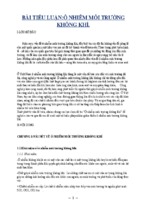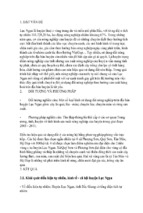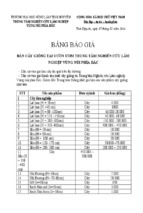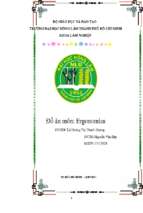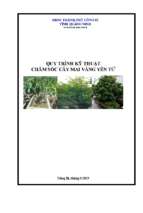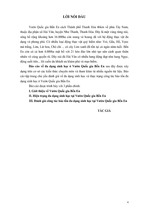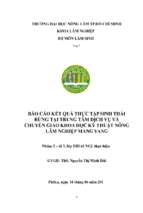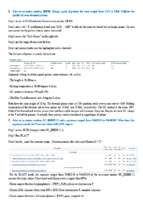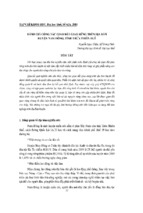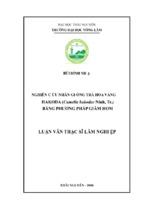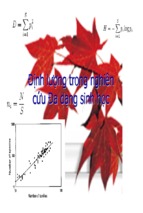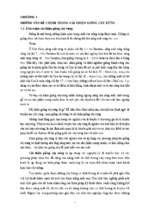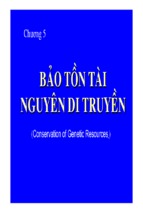THE PROJECT OF PILOTTING AN APPROACH TO MULTIPLE-USE FOREST
MANAGEMENT IN LAM DONG PROVINCE
FUNDED BY TRUST FUND FOR FORESTS (TFF) - GA 019/07
Mid-Term Evaluation Report
Project on
Piloting an Approach to Multiple-Use Forest Management
Lam Dong Province
May 2009
Project Management Unit
5E Tran Hung Dao Street
Ward 10, Da Lat city
Lam Dong province
Tel.: 063 3577246
Björn Wode
Forestry Consultant
[email protected]
1
THE PROJECT OF PILOTTING AN APPROACH TO MULTIPLE-USE FOREST
MANAGEMENT IN LAM DONG PROVINCE
FUNDED BY TRUST FUND FOR FORESTS (TFF) - GA 019/07
TABLE OF CONTENT
1
EXECUTIVE SUMMARY
4
2
INTRODUCTION
8
3
SCALE, OBJECTIVE AND METHOD OF EVALUATION
9
3.1
Objective
9
3.2
Method and Organisation
10
4
MAIN FINDINGS
11
4.1
Project Design
11
4.1.1
Technical Aspects of Design
11
4.1.2
Project Beneficiaries
11
Project Implementation Results
12
4.2.1
Project Output 1
12
4.2.2
Project Output 2
14
4.2.3
Project Output 3
18
4.2.4
Project Output 4
23
4.2.5
Cross-cutting issues
24
4.3
Budget, Expenditure and Timeframe
25
4.4
Project Reporting and Monitoring
26
5
CONCLUSION
27
6
RECOMMENDATIONS
31
4.2
List of Annexes
Annex 1:
Terms of Reference
Annex 2:
Mission Itinerary
Annex 3:
Documents Reviewed
Annex 4:
Proposed format for Training material
Annex 5:
General Operational plan for the whole Period of the Project
2
THE PROJECT OF PILOTTING AN APPROACH TO MULTIPLE-USE FOREST
MANAGEMENT IN LAM DONG PROVINCE
FUNDED BY TRUST FUND FOR FORESTS (TFF) - GA 019/07
Glossary of Acronyms
TFF
Trust Fund For Forest
GIS
Global Information System
RCF
Revolving Credit Fund
SUF
Special-use forest
WPF
Watershed Protection Forest
DARD
Department for Agriculture and Rural Development
FMU
Forest Management Unit
NTFP
Non-Timber Forest Products
CTA
Chief technical Advisor
PES
Payment for Ecosystem Services
ODA
Overseas Development Aid
REDD
Reduced Emission through Avoided Deforestation and Forest
Degradation
Explanation of technical terms
Multiple-use Forest Management
The attempt to manage a forested area in a way that reconciles biodiversity
conservation, environmental protection, and production objectives with poverty
reduction for poor, forest-dependent communities.
Payment for Ecosystem Services (PES)
Payment for Ecosystem Services (PES) programmes, alternatively named Payment for
Environmental Services programmes, promote the conservation of natural resources in
the marketplace. PES programs provide incentives for the private sector to incorporate
sustainable practices into production and resource management.
PES programs are voluntary and mutually beneficial contracts between consumers of
ecosystem services and the suppliers of these services. The party supplying the
environmental services holds the property rights over an environmental good that
provides a flow of benefits to the demanding party in return for compensation.
Cover photo:
Stakeholder meeting at Ta Nung commune with participation
from FMG member and Protection Forest Management Board
Lam Vien.
3
THE PROJECT OF PILOTTING AN APPROACH TO MULTIPLE-USE FOREST
MANAGEMENT IN LAM DONG PROVINCE
FUNDED BY TRUST FUND FOR FORESTS (TFF) - GA 019/07
1
EXECUTIVE SUMMARY
Acknowledgement
The mission would like to express their gratitude to all project members for their kind
support and fruitful discussions which contributed and substantially shaped the outcome
of this assignment.
Special thanks for all visited project beneficiaries from various administrative levels for
their warm welcome, active participation and open discussions.
Mission activities
The review mission was fielded for a period of 10 days in Lam Dong province to assess
project implementation results after a period of nearly two years of project
implementation.
The review team visited all project beneficiary groups including i) Forest Management
Groups at village level, ii) six Forest Management Units representing organisational
bodies of all three forest use types in Vietnam, and iii) representatives of the provincial
working group under DARD Lam Dong within a period of six days. During field visits
intensive interviews with project beneficiaries and reviews of developed project materials
were conducted.
Preliminary mission findings were presented at provincial level on the 11th of May and
during a final workshop in Hanoi with participation of a wider audience from TFF and
donor representatives on the 29th of May. Received comments have been incorporated
into the final mission report at hand.
Project design
The project on Piloting an Approach to Multiple-Use Forest Management in Lam Dong
Province has been approved by Decision 780/QN-BNN-HTQT, dated 22nd of March 2007
by MARD. Subsequently, a Grant Agreement has been signed between The Forest
Sector Support Partnership Coordination Office and The Department of Agriculture and
Rural Development in Lam Dong province for implementation of the project from the 22nd
of March 2007 until 2010, with a total project budget of 926,092 EURO.
The Overall Objective of the project is to maximize the contribution of Vietnam’s three
forest management categories to reducing poverty, providing environmental services,
sustaining biodiversity values, and supporting national economic development.
The Purpose of the project is to pilot and define necessary parameters for the
establishment and replication of a multiple-use approach to forest management that
reconciles biodiversity conservation, environmental protection, and production objectives
with poverty reduction for poor, forest-dependent communities. Project interventions are
intended to put in place a basis for planning and regulations consistent with the multiple
forest sector objectives of SUFs, WPFs, and production forests.
The project furthermore pilots collaborative management schemes to involve forest
dependent population into sustainable forest utilisation and protection as contribution to
one main objective of the national forestry strategy of Vietnam.
4
THE PROJECT OF PILOTTING AN APPROACH TO MULTIPLE-USE FOREST
MANAGEMENT IN LAM DONG PROVINCE
FUNDED BY TRUST FUND FOR FORESTS (TFF) - GA 019/07
Project impact
Overall project impact is evaluated consistent towards the achievement of the project
purpose and directly contributing to provincial forest policy development and strategic
planning with major project concepts already applied by relevant departments.
Project implementation is making satisfactory progress with major outputs as defined in
the logframe expected to be achieved by end of the project period.
Project reporting procedures on finance and activity level are up to standard and are
seen as a crucial precondition to effectively implement a project with such a complex
activity schedule. Consultant outputs are available in bi-lingual form and are signed by
the head of the consultancy package, the Chief Technical Advisor and the Project
Management Unit.
The project has gained the support and trust of provincial decision-makers and the
provincial working group is providing an excellent forum to disseminate project activities
at a provincial and regional level.
The project timing in the context of forest development in Lam Dong province is
considered excellent with numerous provincial activities coincide with project activities,
e.g. forest valuation for land allocation/leasing schemes, provincial action plan for
biodiversity conservation as well as planning for PES implementation.
Provincial departments are pro-actively incorporating project outcomes into provincial
programs and policies, thus ensuring that project outcomes will become integrated
components of provincial forest management planning. Thus, institutionalising of project
concepts seems feasible for some concepts (e.g. forest valuation) given the current
demand during new provincial planning and financing schemes. New funding options
under provincial and national programs/projects are furthermore providing very
promising tools to be explored in view of sustaining tangible benefits for local
communities as project areas are clearly earmarked in provincial PES schemes.
The project is embarking on a comprehensive capacity building scheme for FMU and
provincial beneficiaries with numerous surveys and training activities conducted by
project consultants responsible for a specific consultancy package.
In general, the level of understanding, interest in, and application of training results
widely differs between beneficiary groups at FMU and provincial level. Provincial
beneficiaries state a clear interest in project activities and already apply training
outcomes into strategic planning and policy development while FMU beneficiaries still
show a rather passive attitude mainly limited to participation in training exercises only. A
reason for this might be that some training aspects (forest zonation, forest valuation) are
actually not part of the legal mandate nor professional working areas of most FMU
members but are conducted by provincial service providers under state funding. A
widened scope of capacity building should therefore be continued including service
providers from outside the current project beneficiaries.
Six Forest Management Groups (FMG) are operational and effectively using a Revolving
Credit Fund established by the project. However, FMGs still remain with a solely focus
on forest protection and their sustainability rely on external funding form ongoing forest
protection contracts under 661 program schemes. Further projects efforts are therefore
required to promote a shift in their involvement from passive contract receivers to active
forest managers by developing sustainable collaborative management regimes. In this
context it needs to be mentioned that so far no agreement on a concept for collaborative
management has been reached. This is seen as of major concern as this output forms
the basis to generate short-term tangible benefits for the local population and need to be
speed-up by the project by all means.
5
THE PROJECT OF PILOTTING AN APPROACH TO MULTIPLE-USE FOREST
MANAGEMENT IN LAM DONG PROVINCE
FUNDED BY TRUST FUND FOR FORESTS (TFF) - GA 019/07
The revolving credit fund is effectively used by FMG members and interviewed users
proposed only minor adjustments for further improvement. It has to be noted that despite
being described in the project design, the fund volume is not sufficient to provide
substantial impacts to improve livelihood of local people but is understood as a
contribution to achieve a synergistic effect with other socio-economic development
schemes only. It is further understood that income opportunities from unregulated forest
utilisation are by far exceeding the finance provided through the RCF.
At present, eligibility for funding is restricted to FMG members whereas villagers with
highest levels of forest dependency, lowest forest protection awareness and most likely
unsustainable forest utilization patterns are currently not eligible, limiting a major
objective of the RCF namely to reduce pressure on forest resources through alternative
income sources. During the second and subsequent funding cycles priority will therefore
be given to community members with highest levels of forest dependency, poverty rate,
unavailability of arable land and limited sources of alternative income.
The project has conducted detailed surveys and obtained large databases which
however have not yet been fully utilised during analysis, planning and field
implementation. A strong focus for the remaining project period is therefore defined by
analysing and integrating developed data into project interventions and ultimately into
legal planning documents. Strongest focus should be given to simple and feasible
benefit sharing regulations for NTFP utilisation by local people with minimised reporting,
approval and monitoring procedures which can otherwise not be sustained after project
termination.
Forest management plans for six FMUs have been completed as outcome under
consultancy package no.1, however are evaluated as not satisfactory to be utilised as
legal planning basis by a FMU. FMU plans are currently developed parallel to existing
legal planning documents of the respective FMUs and have therefore no legal status
based on which activities could be planned, funded and finally implemented. This is seen
as a major concern as FMU plans are the main tool to ensure an integration of project
outcomes into administrative procedures and subsequently the institutionalisation of the
approach itself. Further improvement of forest management plans is therefore requested
and the project is going to engage in the development of five-year forest management
plans for six selected FMUs for the planning period 2010-2015 to be approved at
provincial level.
Remaining project period
For the coming project period, a clear focus should be given on detailed reflection of
implementation results and achieved impacts for a continuous improvement of newly
tested concepts. At present project implementation revealed to be rather mechanical and
target oriented which is to some extend understandable due to enormous amount of
activities described in the logframe.
The mission therefore emphasises main expected outcomes of the project under the i)
establishment of well-implemented and documented models in the field, ii) the
development of comprehensive, standardised material with distinct formats for training
and technical guidelines and iii) continuous contribution to provincial policy development
by piloting new funding mechanisms.
Furthermore did interviews reveal that the holistic concept of multiple-use forest
approach with all involved and interlinked activities is not yet understood by all project
beneficiaries. Interviews revealed that project interventions remain as fragmented
outputs and have not yet been aggregated into a sustainable product. Due to the current
minimalist project structure with only four positions, a comprehensive coaching of project
beneficiaries is however not considered feasible and it is therefore proposed to seek for
6
THE PROJECT OF PILOTTING AN APPROACH TO MULTIPLE-USE FOREST
MANAGEMENT IN LAM DONG PROVINCE
FUNDED BY TRUST FUND FOR FORESTS (TFF) - GA 019/07
additional funding from TFF for an additional full-time technical advisor at the project
management unit to ensure continuous coaching of FMUs and FMGs after and between
training courses and to encourage and guide FMUs to apply project concepts in their
daily work.
Due to an extended inception phase of the project with prolonged time requirements for
tendering, project implementation could not yet initiate all proposed models in the fields.
Furthermore do recent policy changes, new financing mechanisms and provincial
projects provide further options for sustainable funding mechanisms that were not
considered in the original project design, however are considered as crucial options to
be tested in view of sustainability of project models.
It is therefore proposed to seek for a six months extension, until September 2009 to
guarantee a sound and sustainable development of project models under new financing
schemes and to embark on the preparation of five-year management plans for Six FMUs
representing management of three different types of forests to be approved by PPC Lam
Dong.
7
THE PROJECT OF PILOTTING AN APPROACH TO MULTIPLE-USE FOREST
MANAGEMENT IN LAM DONG PROVINCE
FUNDED BY TRUST FUND FOR FORESTS (TFF) - GA 019/07
2
INTRODUCTION
The project on Piloting an Approach to Multiple-Use Forest Management in Lam Dong
Province has been approved by Decision 780/QÐ-BNN-HTQT, dated 22nd March 2007
by MARD. A Grant Agreement has been signed between The Forest Sector Support
Partnership Coordination Office and The Department of Agriculture and Rural
Development in Lam Dong province for an implementation period of 36 months, from
22nd March 2007 to 22nd March 2010, with a total project budget of 926,092 EURO.
The Overall Objective of the project is defined as to maximize the contribution of
Vietnam’s three forest management categories towards poverty reduction, provision of
environmental services, sustaining biodiversity values, and supporting national economic
development.
The project is structured along four main outputs:
1. Capacity of Lam Dong Department of Agriculture and Rural Development (DARD),
Forest Department, and selected FMUs, Districts and Communes in multiple-use
forest planning and management, forest valuation, and collaborative forest
management increased;
2. Multiple-use management piloted at selected Forest Management Units (FMUs) in
Lam Dong Province;
3. Mechanisms for enhanced community participation in planning, development,
management and benefit sharing established at selected Special-use Forests
(SUFs), Watershed Protection Forests (WPFs) and Production forests;
4. Best practice models of multiple-use forest management documented and
disseminated, to encourage replication of the approach.
The Project Purpose is to pilot and define necessary parameters for the establishment
and replication of a multiple-use approach to forest management that reconciles
biodiversity conservation, environmental protection, and production objectives with
poverty reduction for poor, forest-dependent communities.
Project interventions are intended to put in place a basis for planning and regulations
consistent with the multiple forest sector objectives of SUFs, WPFs, and production
forests. The new legislative framework for the forest sector provided by the 2004 Forest
Protection and Development Law, presents an opportunity to pilot innovative,
community-based approaches to forest stewardship to be piloted by the project.
Implementing and executing agencies are Lam Dong Department of Agriculture and
Rural Development (DARD) and Bi-Doup-Nui Ba National Park, respectively.
This mission was designed to embark on a mid-term evaluation of the project
implementation status and project impacts and to derive at recommendations for the
remaining project period. The mission was fielded for a period of 10 days during which
stakeholder meetings at village, commune and provincial level have been conducted.
For detailed information about the Terms of Reference please refer to Annex 1. The
mission itinerary is provided in Annex 2.
For a list of documents reviewed during the period of the assignment kindly refer to
Annex 3.
8
THE PROJECT OF PILOTTING AN APPROACH TO MULTIPLE-USE FOREST
MANAGEMENT IN LAM DONG PROVINCE
FUNDED BY TRUST FUND FOR FORESTS (TFF) - GA 019/07
3
SCALE, OBJECTIVE AND METHOD OF
EVALUATION
3.1
Objective
The purpose of the project mid-term monitoring and evaluation is to (1) review
systematically and objectively management and operation of the project from the start of
the project to the time of evaluation; (2) to provide findings, conclusions, proposals and
recommendations of changes relating to the project design and activity plans for
remaining time of the project. The conclusions of evaluation will help the project to carry
out effectively objectives and outputs of the projects.
The mid-term evaluation will focus on following activities:
• Monitoring the progress of implementing of the project compared with plans
approved; evaluating the implementation of the overall objective, purpose and
results of implementing activities of the project through indices presented in
logframe of the project.
• Evaluating the results of the project implementation. The project mid-term
evaluation will be carried out based on five following criteria:
•
Evaluating the impact of the project: Evaluating influences of the project on
changes in economy, society and environment of localities and the FMUs in
project area. This evaluation will be based on indices achieved in logframe for
overall objective of the project.;
•
Evaluating effectiveness of the project: Effectiveness of the project will be
evaluated based on analysis and assessment of purpose and outputs of the
project. Through collecting data for indices of implementing purpose and outputs
of the project presented in the project logframe, effectiveness of implementation
of the project will be evaluated objectively and precisely;
•
Evaluating efficiency of the project implementation: Efficiency of the project
will be evaluated through achievement of outputs and activities of the project.
The sources of capital invested for activities of the project to obtain desiring
outputs will be analysed to examine effectiveness of the project;
•
Evaluating relevance of the project: Assessment of relevance of the project is
to answer the question: to what extend does the project overall object and
purpose meet the demands and priorities of target groups of the project? These
groups are expected to be beneficiaries from the project.
•
Evaluating sustainability of the project: So as to assess sustainability of the
project, it is necessary to evaluate and estimate ability of maintenance and
replication of outputs and purpose and overall objective of the project after the
project has completed.
•
Recommend measures, added activities and extending time of project (if
necessary) for achievement of purpose and outputs proposed of the project.
9
THE PROJECT OF PILOTTING AN APPROACH TO MULTIPLE-USE FOREST
MANAGEMENT IN LAM DONG PROVINCE
FUNDED BY TRUST FUND FOR FORESTS (TFF) - GA 019/07
3.2
Method and Organisation
The group of experts of the mid-term evaluation will collect needed information by
following activities:
•
Review related project documents (Grant Agreement, logframe, Project
Implementation Manual);
•
Review technical and financial reports carried out by the PMU;
•
Interview (directly or by questionnaires) beneficiaries of the project, including staff
of Lam Dong DARD and the FMUs in the project area, authorities of districts,
communes and local communities in the project area;
•
Organise workshops with six Forest Management Groups to collect information
on implementing the Revolved Credit Fund of the project, the roles of the fund in
improving the livelihood for local people and contributing to increasing the
effectiveness of forest protection and management in relative hamlets;
•
Examine resulting documents of the project and evaluating the outputs of the
project through these documents;
•
Analyse the reports on socio-economic implementation and implementation of
tasks in the year 2008 of relative districts, communes, the FMUs and Lam Dong
DARD;
•
Analyse satellite images to assess the changes in forest resources in the project
area; Comparing data in forest resources of the project area after one year of
implementing the project;
•
Carry out field surveys in two relative FMUs to evaluate impacts and
effectiveness of implementing the activities of the project.
10
THE PROJECT OF PILOTTING AN APPROACH TO MULTIPLE-USE FOREST
MANAGEMENT IN LAM DONG PROVINCE
FUNDED BY TRUST FUND FOR FORESTS (TFF) - GA 019/07
4
MAIN FINDINGS
4.1
Project Design
4.1.1
Technical Aspects of Design
The project design is structured along a logframe which follows the conventional
hierarchical approach of Objective, Purpose, Activities and Results. The logical hierarchy
is sound and the activities are clearly stated with attached Indicators and Verifiers.
The logframe is currently revised and integrated into a project monitoring system under
consultancy package no. 6 and modifications described in a draft version 1 in Vietnamese
only.
The ambitious project design is detailing a total of 22 activities under four outputs. This
large amount of activities and intended linkages towards a holistic approach of multipleuse forest management is evaluated as still being too complex for most involved
stakeholders. Interviews and field visits revealed that project interventions remain
fragmented pieces and have not yet been combined into a sustainable product. Most
project participants were not able to present a logical sequence of all project activities
but were only able to recall individual events.
A major challenge of the project remains therefore with bringing together all these
aspects into vital models with an attached practical guideline for independent replication
after project termination.
4.1.2
Project Beneficiaries
Project activities are targeting four distinct groups of beneficiaries, who are engaged in
the piloting of multiple-use forest management:
•
Forestry-related government authorities (Lam Dong DARD; Lam Dong Forest
Department, Forest Protection Department, and other functional Departments
within Lam Dong DARD)
•
Six Forest Management Units (FMUs) representing managerial bodies for the
three distinct forest types (special-use, protection and production forest)
•
District authorities of Lac Duong, Don Duong, and Da Lat city, with their
respective communes. Project counterparts are People's Committees and agroforestry extension staff.
•
Forest-dependent communities living within, and in the vicinity, of the above six
FMUs.
Selection of beneficiaries is evaluated supportive to the project purpose with increasing
attention to be paid at provincial level during the remaining project period in view of
institutionalising of developed concepts.
1 Duong Tien Duc (June 2008): Draft monitoring, lessons learnt and experiences from Project on piloting an
approach to multiple-use forest management in Lam Dong province
11
THE PROJECT OF PILOTTING AN APPROACH TO MULTIPLE-USE FOREST
MANAGEMENT IN LAM DONG PROVINCE
FUNDED BY TRUST FUND FOR FORESTS (TFF) - GA 019/07
4.2
Project Implementation Results
4.2.1
Project Output 1
Out Put 1: Capacity of Lam Dong DARD and Forest Department and selected FMUs,
districts and communes in multiple-use forest planning and management, forest
valuation, and collaborative management increased
Activity 1: Conduct a participatory assessment of gaps in technical capacities to plan
and manage forest of high conservation value.
A comprehensive training needs assessment for all project FMUs has been
conducted for six skill areas and documented in September 2008 (Mahood, Hung,
Me). However, training implementation started already prior to the training need
assessment and was mainly based on the project design, thus limiting the
effectiveness of this exercise to some extend.
Activity 2: Carry out training to fill technical gaps in forest planning and
management for relevant Lam Dong DARD, Forest Department, Forest Protection
Department, FMU personnel and some other provincial institutions directly involved
in forest management and planning.
Capacity building conducted by the project focussed on forest inventory, identification
of flora and fauna, GIS application, and zonation of multiple-use forest zones and
has resulted in increased awareness and improved capacities.
FMU members are able to recall main training outcomes, however do not yet gained
a general overview over the entire project concept and cannot recall a logical
sequence of implementation steps and how specific activities are interrelated. This is
understandable during the ongoing implementation stage, however following the
sequence of training courses participants should be developed towards an overall
understanding of all involved steps towards the multiple-use forest management.
As revealed in one training report some training aspects have been evaluated as not
satisfactory, however no adjustments in the training material are visible to the
consultant which could lead to an improved implementation during subsequent
courses. It is obvious that consultancy documents are not adjusted based on the
implementation results but only based on the expertise of the provincial working
group prior to the implementation. However, during this stage of methodology
development a constant refinement of the concept and accompanied documents
before and after implementation should be supported by the project.
Training activities should be followed-up by continuous coaching of a project
technician during real work. However, the current project structure does not comprise
such a position (see chapter 4.2.5). Consequently, training is conducted by external
consultants as a one-time exercise only, questioning the sustainability of the
developed technical/managerial capacities at FMU and FMG level.
Activity 3: Carry out training on forest valuation for relevant Lam Dong DARD, Forest
Department, Forest Protection Department, FMUs personnel and some other
provincial institutions directly involved in forest management and planning.
Training on forest valuation has been conducted and results documented in a
training document 2, a guideline on forest valuation in Vietnam 3 and minutes of
meetings of training implementation.
2 Phuong, Que, Hong (July 2008): Training document on forest valuation
3 Phuong, Que, Hong, Ha (Nov. 2008): Guideline on forest valuation in Vietnam
12
THE PROJECT OF PILOTTING AN APPROACH TO MULTIPLE-USE FOREST
MANAGEMENT IN LAM DONG PROVINCE
FUNDED BY TRUST FUND FOR FORESTS (TFF) - GA 019/07
FMU members were able to recall the main training objective, however could in most
cases not clearly explain the relevance of it when applying it in their current working
environment.
The forest valuation guideline is describing a number of variables (increment, mean
average stand height…) that are i) not available in Vietnam and ii) have not been
used in the forest valuation training model. Furthermore, some criteria should be
reviewed regarding their scientific plausibility (e.g. soil erosion mainly depends on
the slope, however no slope estimate is applied in the calculation).
Of outmost importance, options for applying forest valuation in the specific context of
a FMU should be further explored and tested (e.g. forest valuation could be used to
calculate the economic loss from forest violation and patrolling and could be used as
basis for sustainable FMG compensation schemes) to ensure that gained knowledge
is used and maintained.
During a meeting with provincial representatives a strong interest in forest valuation
was articulated and project training outcomes have already been integrated into
provincial forest policy development and applied during valuation of forests
earmarked for allocation to organisations and individuals 4.
Future training support should therefore be clearly linked to develop technical skills
required to design provincial plans and programs, thus requiring a close coordination
with the provincial working group.
The project should therefore coordinate further training efforts in view of supporting
ongoing provincial programs/action plans and by this ensure that project procedures
become an integrated part of the legal environment.
Activity 4: Conduct training on collaborative management approaches in forest
management for relevant Lam Dong DARD, Forest Dept., District, Commune, and
FMU staff.
No agreement on the concept for collaborative management has been reached so
far. The first draft of the national consultant team 5 has been discussed during a
provincial meeting and is still under revision. As perceived by the mission, the
proposed concept is misinterpreting the overall project goal and is proposing
conventional procedures of “community forestry” as already applied in many ODA
projects in Vietnam such as the TFF funded Community Forestry Pilot Program (TFF
GA 014/06) or the provincial project with seven CFM models established in Lam
Dong province. Forest allocation (red book certificates) to local communities forms
the core of the proposed concept which, under the current legal system of Vietnam,
is only applicable for areas classified as production forest. The project design
however does not foresee forest allocation to local communities and is not equipped
with sufficient budget facilitate forest allocation procedures in six pilot villages.
Following results of the re-classification of three types of forest in Lam Dong province
(Decision 450/QD-UBND, dated 19th February 2008) production forest accounts for
only 26% of the total project area. Consequently, involvement of local people in the
project context is only feasible in form of management agreements and benefit
sharing arrangements between the land use certificate holder (FMU) and the local
communities. Land ownership in this case clearly remains with the certificate holder
which means the FMU only.
The joint stock seed company could serve as an example as it has independently
conducted a scheme for collaborative management in which households are
4 A total of 45.000 ha of forest in Lam Dong province are earmarked to be leased out to 320 organisations
and individuals
5 Vu Ngoc Long, Le Buu Thach (May 2008): Training material on Approaches on Collaborative Forest
Management
13
THE PROJECT OF PILOTTING AN APPROACH TO MULTIPLE-USE FOREST
MANAGEMENT IN LAM DONG PROVINCE
FUNDED BY TRUST FUND FOR FORESTS (TFF) - GA 019/07
assigned 5-7 ha of forest land inside the FMU (gaps of bare land or open forest) for
underplanting with fodder species for pig raising. The company further proposed to
provide labour to local people after termination of 661 funding schemes.
Activity 5: Conduct training to Lam Dong DARD, Forest Dept., and FMU staff, and in
particular local Forestry Management Groups, on monitoring and data interpretation
to aid planning and management.
Training on monitoring forest of high conservation value has been conducted and
well documented 6. The document is providing clear guidance on survey techniques,
reporting formats and indicators structures along five high conversation values.
FMU members reported that monitoring will be applied as regular procedures by
assigned technicians as part of their regular job description, thus not requiring any
additional financing. However, the process of how this data will be integrated into
current planning procedures was not yet clearly stated.
Activity 6: Provide basic equipment for forest fire control to each of the FMUs, and
for surveying and monitoring to Bidoup-Nui Ba National Park.
Project financing is not designed nor sufficient to fully equip a respective FMU, but
only to support some, supporting funds based on their demand. Consultations of all
stakeholders have been conducted and technical specifications of equipment defined
accordingly.
Fire fighting equipment has been delivered to all FMUs including trucks equipped
with water tanks and state of the art water pumps. Furthermore, GPS hand receiver,
laptops and camera equipment for monitoring of forest changes have been
purchased and delivered according to schedule.
FMUs have been trained in the use and as revealed in the case of the Da Nhim
Protection Forest Management Board the truck is frequently used for patrolling.
It was reported that the specifications of required equipment have been defined
during joint meetings with involved stakeholders. However, FMU representatives
frequently mentioned difficulties to sustain expenses for operation and maintenance
(in one case no FMU staff has the required driving licence to transport a fire fighting
crew and consequently the truck has not been used so far). On the other hand one
office has found an independent solution and deducted required finance from office
running costs from state budget. Furthermore, it remains to be seen whether in an
extreme sloppy terrain like Lam Dong the provided truck can really access remote
areas for timely forest fighting.
In general, FMU participation still appears to be rather passive and always waiting for
the next project input and not pro-actively working with the so far gained results.
4.2.2
Project Output 2
Out Put 2: Multiple-use management piloted at selected FMUs (comprising special use
forest, watershed protection forest and production forest) in Lam Dong Province
Activity 7: Establish a provincial multi-agency working group to guide piloting of the
multiple-use approach to forest management.
A provincial working group has been established by provincial Decision 741/QDSNN, dated 13th October 2008 and remains operational. The working group is
6 Birdlife (March 2009): Training materials for monitoring of forest of high conservation value
14
THE PROJECT OF PILOTTING AN APPROACH TO MULTIPLE-USE FOREST
MANAGEMENT IN LAM DONG PROVINCE
FUNDED BY TRUST FUND FOR FORESTS (TFF) - GA 019/07
consisting of 17 members from various forestry-related Departments, institutions and
organisations.
The working group has proven extremely effective in involving provincial policymakers right from the beginning into methodology development by the project, thus
directly linking pilot models in the field with policy development in Lam Dong
province.
A clear outcome of this approach is seen in the integration of the forest valuation
procedures as trained by the project in provincial planning procedures under PES
and forest allocation schemes. Furthermore, the multiple-use concept has been
incorporated into the action plan on biodiversity conservation in Lam Dong province,
which as a consequence is not limiting the scope of biodiversity conservation to
special-use forest only but to all three forest types in Lam Dong province.
Activity 8: With provincial working group, develop a set of criteria to evaluate the
status of selected FMUs and prioritize them for implementation of the multiple-use
forest management approach.
A set of criteria for the identification of HVCF sites and resulting forest zonation has
been developed during a two-day workshop 7 and approved by the PMU in March
2009. A total of 17 criteria structured along five main high conservation values are
detailed to be applied during forest zonation exercises in six FMUs. Criteria are
providing relevant and easy to assess features and have been integrated into a
detailed training material 8 and training conducted in March 2009.
Activity 9: Assess present FMU plans and management documents and produce a
SWOT analysis of these and their status for implementation.
As part of consultancy package no. 1 the assessment of six FMU plans and
management documents has been conducted and documented in Nov. 2008 9. The
analysis is providing a general overview on related policies and planning documents
and provides some recommendations for project interventions as result of the SWOT
analysis. Recommendations however remain at a rather general level with only
limited guidance for concrete project interventions and very limited information on the
process of the assessment itself which however would be of importance for the
development of lessons learnt during the final stage of the project documentation.
Activity 10: Conduct forest surveys to identify and prioritize high conservation value
forests in the six selected FMUs.
Based on preliminary results as developed under Activity 13, a BirdLife consultant is
currently fielded in Lam Dong and is conducting forest surveys to prepare a final GIS
database for six involved FMUs. The project has purchased SPOT 5 satellite images
with a resolution of 2,5m to support this activity. However, images have not yet been
interpreted and no ground-truthing being conducted to develop a comprehensive GIS
database, thus limiting the effective use during surveys and zoning exercises. It has
to be mentioned, that based on the project design a too small budget was allocated
to purchase images in Vietnam.
Activity 11: Conduct a demonstrative and comprehensive forest valuation exercise
within the project area.
7 Workshop conducted on the 2nd and 3rd October 2008 with participation from provincial working group, TFF
PMU and FMU members
8 BirdLife (Nov. 2008): Training material for identification, planning and management of forest of high
conservation value
9 Mr Thanh (Nov. 2008): Assessment of planning and management documents of the forest management
units in the project area
15
THE PROJECT OF PILOTTING AN APPROACH TO MULTIPLE-USE FOREST
MANAGEMENT IN LAM DONG PROVINCE
FUNDED BY TRUST FUND FOR FORESTS (TFF) - GA 019/07
Following the forest valuation training three models comprising the three different
forest functions in Vietnam (special-use, protection and production forest) have been
developed with participation of FMU representatives. Results are documented in a
comprehensive report 10 which provides very clear and structured guidance through
the process. The document is providing, with scientific accuracy, all required
information and secondary data for an independent replication.
The document however is limited to the calculation process and provides limited
analysis on the results of each model and how it links to the real work of a respective
forest manager. This knowledge is considered most crucial to ensure that valuation
will in the future become an institutionalized procedure of FMUs concerned.
Interviews with FMU representatives confirmed this knowledge gap with people
being able to recall the main valuation procedure however could not explain how it
relates to their daily working routine.
Activity 12: Define multiple-use zonation within FMUs and management prescriptions
for each zone.
This activity was conducted as part of the consultancy package no. 1 and mainly
involved stakeholder consultations (FMU and FMG) and desk work as preparatory
step for the detailed field mapping exercise under Activity 10. Preliminary result maps
have been produced and are available as hardcopy attached to the planning
documents as developed under activity 13.
Activity 13: Agree with stakeholder FMUs on defined multiple-use forest zoning plans
for their own territories, and incorporate agreed regimes into FMU planning and
management documents.
The project has developed a FMU planning and management document 11
comprising general descriptions for each FMU. The document has been approved by
the head of the consultancy package, the project CTA and the Project Management
Unit in November 2008.
The document is structured along six main topics as mentioned below under which
however only required additional plans are listed to be developed in the future:
•
Zoning for forest utilisation as conducted by the project
•
Plans for conservation/utilisation
•
Building the plan for NTFP utilisation
•
Establishing plan for ecotourism development
•
Building the plans for agro-forestry development
•
Participation of local communities in zones of utilisation
Despite the concept of High Value Conservation forest being introduced during the
forest valuation exercise no reference to this important project concept could be
found in the documented plans.
Attached to the document a very vague time schedule for implementation during the
entire project period is provided which however is not linked to the structure of the
project logframe. The document is therefore lacking main characteristics of a
comprehensive plan with a detailed technical procedures, timing, quantifiable units
for achievements of activities, responsibilities and proposed funding attached.
10 Phuong, Que, Hong, Ha (Nov. 2008): Reports on findings of demonstration forest valuation in Lam Dong
province
11 Mr Thanh (Nov.2008): Report on the plans for forest management of the forest management units in the
project area following the approach of multiple-use forest management
16
THE PROJECT OF PILOTTING AN APPROACH TO MULTIPLE-USE FOREST
MANAGEMENT IN LAM DONG PROVINCE
FUNDED BY TRUST FUND FOR FORESTS (TFF) - GA 019/07
FMU plans are currently developed parallel to existing legal planning documents of
the respective FMUs (five-year management and annual business plan) and have
therefore no legal status based on which activities could be planned, funded and
finally implemented.
Interviews with FMU members further confirmed that the plan has not been
considered during any FMU work so far and that no follow-up after the completion of
the consultancy package is intended. As revealed during interviews, the planning
document is understood as the product of the consultant only and it is questionable
whether FMU members were sufficiently involved in the plan development as they
did not develop any sense of ownership over the outcome.
The project is therefore strongly recommended to revise the current document as
these plans are forming a key tool of integrating project concepts into real working
routine of a respective FMU as a major project goal.
Options for integrating project activities into legal five-year planning procedures are
limited due to the fact that the next planning period will coincide with the project end
in 2010. Project support could therefore only focus on plan preparation without being
able to facilitate subsequent plan implementation.
Attached to the planning document the project has facilitated, apart from existing
administrative forest maps (forest status and three types of forest result map), the
development of two GIS based databases:
•
•
Firstly, following the outcome of the multi-use forest management concept
four major forest use zones have been defined and delineated:
a.)
Conservation zone for rare and endangered flora and fauna
b.)
NTFP utilization zone
c.)
Agro-forestry zone
d.)
Eco-tourism zone
Secondly, based on the NTFP survey as conducted for selected Forest units
the abundance of forest products, distribution and species name are detailed.
Produced maps have been approved by the chief of the consultancy package, the
CTA and the FMU director only. No legal administrative approval has been reached
so far which however is detailed in the project proposal (page 16 “….endorsed by
Lam Dong DARD and District authorities”) as main outcome of this activity.
It is therefore proposed to focus project support on the improvement of the existing
planning documents as mentioned above and to facilitate the development of coming
five-year plans for three project FMUs 12 (each representing a respective forest type)
in close cooperation with the provincial working group aiming at a legal approval in
view of the institutionalization of project concepts.
Five-year FMU management plans are normally contracted out to specialised service
providers with sufficient budget provided by the province. FMUs are not having the
legal mandate to develop their own five-year plans. Institutionalising the project
concept therefore mainly depends on involving provincial service providers into the
methodology development of the project concept. Training courses should therefore
pay special attention to involving FMU members and service providers.
12 As discussed during the provincial meeting on the 11th of May, the provincial working group will support
the project in selecting the FMUs and will provide support during appraisal and approval procedures. It
was agreed that approval would only be required at provincial level through PPC with an
acknowledgment by MARD. However, no legal approval from national level is required nor intended.
17
THE PROJECT OF PILOTTING AN APPROACH TO MULTIPLE-USE FOREST
MANAGEMENT IN LAM DONG PROVINCE
FUNDED BY TRUST FUND FOR FORESTS (TFF) - GA 019/07
Development of the three above mentioned five-year plans should therefore further
involve provincial service providers to ensure a legal planning outcome in view of
reaching a provincial approval and at the same time focusing training efforts on key
personnel for an independent replication of the approach after project termination.
It has been noted that GIS application is based on ArcGIS software package which is
the most sophisticated and scientific tool on the market, however no FMU or district
level authority in Vietnam is applying this software. GIS mapping should instead be
based on commonly used software packages like MapInfo. The simple spatial
analysis as required for the project concept can effectively be conducted by use of
MapInfo and by this minimising costs for training and purchases of expensive
software licenses for which the project budget has not been designed.
In this context it has to be mentioned that no softcopy of the mapping information has
been handed over to the FMU so far, which of course limits any chances of project
results being integrated into routine procedures of a respective FMU.
Activity 14: As a result from pilot FMU field activities, consolidate all variables,
strategies, and working mechanisms into an FMU Multiple-use Forest Management
model.
This activity has not yet been initiated as it is depending on the completion of
preparatory steps with are still ongoing.
4.2.3
Project Output 3
Output 3: Mechanisms for enhanced community participation in planning, development,
management and benefit sharing established at selected WPFs and SFEs, and
possibilities for collaborative planning, management and benefit sharing explored at
selected SUFs.
Activity 15: Assess opportunities and constraints for participation of local communities
in planning and management of FMUs, and define possible co-management.
As detailed under Activity 4, the concept for collaborative management is still under
revision causing an undesirable delay of all subsequent activities under consultancy
package No. 4, especially the provision of tangible benefits for local people as a key
component of the overall project purpose. The project is therefore requested to
speed up this process by all means possible.
Activity 16: Establish community based forest management groups at relevant
villages.
Forest Management Groups have been established in each one village per FMU.
Each FMG consists of twenty members out of which ten are holding positions at
commune or village level. Main selection criteria of FMG members was the ongoing
participation in forest protection contracts under the national 661 program 13. Under
this scheme households are assigned responsible for the protection of a specific
forest area and in return receive a compensation of 100.000 VND/ha/year. This
financing scheme is limited for a period of 5 years per respective forest block only.
FMGs are established based on a specific agreement supported by the project and
approved by respective Commune People Committees in April 2008.
FMG members throughout all visited villages revealed a high awareness for their
responsibility under forest protection and in most cases could furthermore explain the
importance of environmental services from a stable forest coverage.
13 Decision 661/QD-TTg, dated 29 July 1998, also referred to as the "5 million ha afforestation program"
18
THE PROJECT OF PILOTTING AN APPROACH TO MULTIPLE-USE FOREST
MANAGEMENT IN LAM DONG PROVINCE
FUNDED BY TRUST FUND FOR FORESTS (TFF) - GA 019/07
FMG members stated that forest violation has significantly be reduced since the
funding from 661 was received and that effective protection is ensured up to now
under the additional support from the project.
However, as stated in the project proposal “…FMG will comprise households sharing
a common interest in management of forest resources for sustainable harvest and
conservation“ and that FMG with interest in NTFP will be „...likely comprised of
mostly women“. Up to date however, FMGs are solely involved in forest protection
measures and the only female participant is one representative from the women
union and therefore do the current project activities not yet reveal a significant
difference from conventional 661 forest protection schemes.
It is understood that due to the ongoing preparation under Activity 18 NTFP utilisation
has not yet been detailed and tested, thus limiting options for active involvement of
women and FMGs members in active forest management. The project should
therefore speed up the testing and implementation of NTFP management models to
ensure that sufficient experiences can be gained before the termination of the
project.
The project has provided equipment and uniforms to FMGs through the respective
FMUs which only in one case (Ta Nung commune, village 2 and 6) has not yet
reached the members.
FMGs further raise awareness on the importance of forest protection among their
community members and in the case of village Suoi thong A FMG conduct regular
additional meetings among members. On average an individual FMG members
spends 4 days/month patrolling in the forest with additional time during high peak of
dry season.
Farmers stated that without financial support from 661 schemes effective patrolling
could not be continued. In the case of Da Ron commune joint stock and foreign
owned companies are hiring local people for daily labour (40.000 VND/day). Future
payment options after termination of 661 funding (the program will terminate by end
of 2010) therefore have to be explored and based on local opportunity costs as
mentioned above. The most promising option would be a direct linkage to Payment
for Ecosystem Services (PES) schemes which are going to be piloted in Lam Dong
province. An approval of the PES project for Lam Dong has been signed by the
province during the period of this assignment based on Decision 380/2008/QD-TTG,
dated 10th April 2008. The project clearly specifies several project locations to be
included in the PES pilot scheme with an expected funding of 200.000-270.000
VND/ha/year. Within the national park an area of 1.800 ha are already earmarked for
PES out of which 1000ha will be assigned to communities and 800ha to the national
park management board.
As a further incentive for FMG members the project is providing revolving credit
funds (RCF) of 10.000 Euro per village. Priority is given to FMG members which can
borrow up to 10 Mio VND 14 for a period of one year.
During interviews farmers highly appreciated the project funding mechanism
however they also stated that due to the funding limits it cannot provide a significant
contribution to livelihood improvement despite being evaluated as a major impact in
the original project design.
The revolving credit fund is effectively used in all FMGs with in some cases nearly
the entire fund volume being currently used by community members.
14 Only in the case of Da Ron commune, villagers agreed to increase the maximum amount to 15 mio VND
per person as they perceived 10 Mio VND as too little for substantial investment
19
THE PROJECT OF PILOTTING AN APPROACH TO MULTIPLE-USE FOREST
MANAGEMENT IN LAM DONG PROVINCE
FUNDED BY TRUST FUND FOR FORESTS (TFF) - GA 019/07
FMU members could clearly explain issues under fund management and procedures
for village members to get information on fund status, availability and its utilisation to
avoid misuse by the communal staff assigned for fund management and
bookkeeping.
Current limitations of the funding scheme as articulated by FMG members comprise:
•
The current funding period of one year is too short to gain sufficient benefits
from agricultural production and in the case of Lat commune borrowers are
forced to find alternative funding (in the worst case from private money
lenders with interest rates of up to 30%) to bridge the time gap until revenues
from harvested crops will be available. It was therefore proposed to extend
the funding period up to a maximum of 2-3 years depending on a plenary
village decision.
•
Funding volume per person is considered too low to provide a basis for
substantial investment (it was mentioned that funding is not even sufficient to
purchase a single mature cow). It was proposed to allow a more flexible
regulation and to lift up the maximum fund volume per person to up to 15 Mio
VND to be defined through majority vote during plenary village meetings.
During the first revolving cycle (one year), eligibility for receiving RCF is limited to
FMG members to provide additional incentives for FMG members and to ensure
responsible fund utilisation in view of developing good examples for other community
members. It was stated that this was partly demanded by FMG members.
However, by applying this system community members with highest levels of forest
dependency, lowest forest protection awareness and most likely unsustainable forest
utilization patterns are currently excluded from funding through the RCF. Therefore,
limiting a major objective of the RCF namely to reduce pressure on forest resources
through alternative income sources.
It should be noted that most buffer zone development projects and integrated
conservation and development projects in Vietnam failed to develop clear linkages
between rural development interventions and conservation benefits. It is therefore of
outmost importance to review current selection criteria for funding in view of closely
linking pressure on forest resources (forest dependency, poverty and lack of
alternative income sources) to eligibility of funding. By this funding is directly
contributing to conservation objectives of the project and is at the same time
ensuring a targeted pro-poor financing.
It is therefore strongly recommended to timely facilitate plenary village meetings and
to discuss on adjusted criteria for fund eligibility for the second and subsequent
revolving cycles. Main criteria should be based on forest dependency, poverty rate,
unavailability of arable land and lack of alternative income sources.
In the case of Da Ron commune, people have lost forest area with mosaic like
patches of traditional and stable agricultural fields to a company developing a tourist
site. Apart from the loss of agricultural income the payment under 661 schemes is
further adjusted to the reduced total forest area. As the community is not holding any
legal land use certificates (so-called red books) only marginal compensation from the
state is expected.
However, forest protection activities from the community in the past and in the future
are crucial to ensure the tourist value of the site (especially fire protection measures)
thus providing clear benefits for both the community in terms of watershed protection
and for the company.
20


